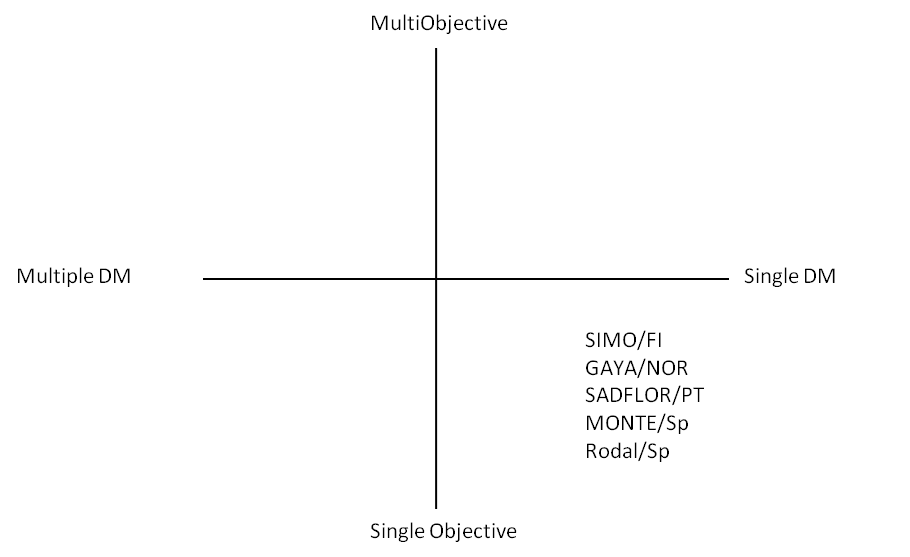2011-06 Thessaloniki Case Study Notes cross WG
(Compiled by Ola Eriksson)
During 1 hour at the meeting members of different WGs met and discussed ideas concerning the case studies, their purpose, scope and practical implementation. The members of the STC on country reports were taking notes of the discussions.
Contents
Discussion on problem types selection (Antoni Trasobares)
- Identify common points for selection between groups
- Nr of cases? Max of 10 probably
- Quantitative vs Qualitative approaches for selection
- For WG4 more interest on case specific studies (e.g. Valencia) while other groups looks for good general representation in terms of region, development approach, context etc.
- The regional approach grouping may be a good starting point.
- For WG4 the process is the main point while for other groups success for producing good results (appropriate management plan according to objectives.)
- Topic oriented case studies? Climate change etc..; technology level for grouping cases;
- Case studies selection could be addressed from the researchers, developers, and users stakeholders point of view, similar to the new approach proposed for using the WIKI
- Gordon’s example, he selected case studies according to planning cases/problem types
- Case studies: information useful for the guidelines; working groups should be the drivers for the selection!
- Crucial point for the selection exercise: to whom are we addressing the guidelines!
Case studies (Teppo Hujala)
- Logistics planning (tactical/operational) and integration with other types of information systems (GIS, RS, accounting etc.)
- Running flexible strategic planning processes: how is it manageable?
- Most common (additions from nearly similar prob. types.) regional / forest / stand level problem types comparison of tools, methods etc. and lessons learned.
- Flood preserve planning (Hungary)
- Assessment of “fast” software for operational problems.
- Assessment of non-DSS computerized tools and why they are used, how they perform and whether they could be integrated with or replaced by full DSS functionalities.
Discussion on potential in-depth case studies, June 7, 2011, (Eva-Maria Nordström)
Criteria for selection of case studies
- Problem types should involve stakeholders, but it is probably not realistic that all cases are participatory.
- The most common problem types should be addressed by at least one case study each.
- Go back to the problem type dimensions, reduce the number of dimensions (e.g. the goods and services dimension produces many variations on similar problems) and find out which “reduced” problem types are most common
Potential cases
- Both successful and unsuccessful cases should be included.
- Cases of development of a DSS, e.g., Simo, could be included.
- Make comparative studies of the development of decision support in one or more regions with similar preconditions, e.g., the Nordic countries. What made these DSS successful/unsuccessful? What were the conditions? (But potentially sensitive issue if specific persons are mentioned?)
- Cases where specific methods are used? E.g., MCDA, …
- Cases where tools are lacking, e.g, for assessing climate change
- AFFOREST: DSS for strategic planning where stakeholders were involved in development. Example of “failure” because no one is using it.
- The Lycksele case (Nordström et al. 2010)
Case studies discussion (Jordi Garcia-Gonzalo)
First of all there is quite confusion among participants about the objective of the case studies and especially about the content of them. After discussing for a while what the possible content of a study case is we proceed to develop a methodology to select potential cases rather than eliciting a list of potential cases.
- We all agree that the most common problem types should be addressed.
- Due to the large number of potential problem types we developed a methodology to cluster them.
Methodology
This methodology would be used to find: i) problem types where more than one DSS exists (this would allow a study cases comparing DSS that address the same problem type), ii) problem types where no DSS is found (this would allow us to identify study cases that analyze whey there are no DSS for these problem types):
- The first step is to select some main dimensions (e.g Multi-objective vs Single objective, and Multiple DM vs Single DM). This may be represented in a graph as shown in this document.
- Locate in the graph the different DSS or computerized tools identified.
- Add another dimension and see which of the DSS/tools address these problems
- Continue adding dimensions until finding problem types that are addressed by different DSS/tools or to find problem types that do not have any DSS/tool.
Potential cases that were also discussed
- Why large countries do not use DSS at all – compare with the Swedish case where the use of DSS is common.
- Existing Stand level DSS and compare methods they use.
